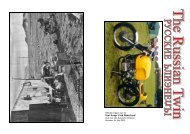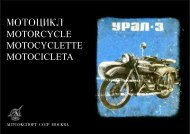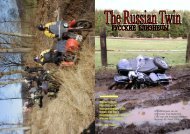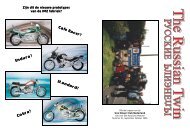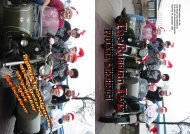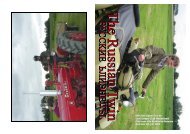Carburetor K65T - motorcycles "Urals", "the Dnepr -11 ... - Udcn
Carburetor K65T - motorcycles "Urals", "the Dnepr -11 ... - Udcn
Carburetor K65T - motorcycles "Urals", "the Dnepr -11 ... - Udcn
Create successful ePaper yourself
Turn your PDF publications into a flip-book with our unique Google optimized e-Paper software.
Adjustment and overhaul of <strong>the</strong> Pekar K-63 and K-65 <strong>Carburetor</strong>s<br />
Curt Peredina http://www.russiancycles.com<br />
Pekar K65 <strong>Carburetor</strong><br />
Copyright 2006 Curt Peredina http://www.russiancycles.com Reproduce only with permission.
Introduction<br />
This manual was designed for <strong>the</strong> <strong>Dnepr</strong> enthusiast interested in getting to know <strong>the</strong>ir<br />
Pekar K65/63/62 carburetors. I will cover basic operation, tuning, and overhaul; all of<br />
which are relatively simple. Before disassembly, you should understand <strong>the</strong> basic<br />
concepts of carburetion, which, are as follows:<br />
1. Air enters <strong>the</strong> carburetor throat through <strong>the</strong> air filter system;<br />
2. Fuel from <strong>the</strong> tank, which is metered into <strong>the</strong> bowl by <strong>the</strong> float mechanism, is<br />
siphoned up through <strong>the</strong> jets (depending upon <strong>the</strong> amount of air entering), into<br />
<strong>the</strong> throttle body by <strong>the</strong> passing air and low pressure where it is atomized into an<br />
approximate mixture of 14.7:1 (weight). This air volume is changed by <strong>the</strong> height<br />
of <strong>the</strong> slides, drawing more or less fuel, directly controlled by <strong>the</strong> throttle. Since<br />
each unit has it’s own cable, it’s important that each slide operates somewhat <strong>the</strong><br />
same as <strong>the</strong> o<strong>the</strong>r.<br />
3. The air/fuel mixture passes into <strong>the</strong> body of <strong>the</strong> carburetor, past <strong>the</strong> intake seals,<br />
and into <strong>the</strong> combustion chamber<br />
Depending upon <strong>the</strong> operating range, this is mostly dependent upon <strong>the</strong> idle jet and idle<br />
mixture screw (idle), radius of <strong>the</strong> jet needle (1/8 to 1/4 throttle), tapered section of jet<br />
needle and main jet (1/4 to open throttle). These are sometimes called <strong>the</strong> Idle system,<br />
intermediate system, and high speed system. If <strong>the</strong> engine runs well at idle and all is<br />
tuned, but you get pinging or knocking under load, if it’s not a timing issue, it might be an<br />
overly lean mixture. Adjust <strong>the</strong> jet needle as necessary to compensate. It’s easy….<br />
Now, when everything is cold, fuel doesn’t vaporize well, and this is where <strong>the</strong><br />
enrichining, or choke system is used. With <strong>the</strong> K65, this is <strong>the</strong> knurled rod which twists<br />
up and rotates 90 degrees to lock. This unports ano<strong>the</strong>r jet which allows an enrichened<br />
mixture into <strong>the</strong> chamber. This system is dependent upon springs and seals to properly<br />
operate.<br />
How to operate in <strong>the</strong> cold wea<strong>the</strong>r? Open <strong>the</strong> fuel shutoff valve, depress <strong>the</strong> ticklers<br />
(float depressors) a few times, activate <strong>the</strong> choke, and it should start immediately.<br />
Simple. Really…a tuned <strong>Dnepr</strong> carburetor usually operates very well.<br />
The next steps are to tune and possibly disassemble and overhaul <strong>the</strong> unit. This is<br />
relatively easy, requiring only a few tools and a clean work area (lots of little bits). Even<br />
better, purchase an overhaul kit (described later).<br />
Any questions or comments, let me know. Send an email to curt@russiancycles.com.<br />
Copyright 2006 Curt Peredina http://www.russiancycles.com Reproduce only with permission.
I. Adjustment of K65-K63 carburetors used on <strong>Dnepr</strong> and Ural <strong>motorcycles</strong>.<br />
Prior to commencing carburetor adjustment, check <strong>the</strong> electrode gaps on <strong>the</strong> spark plugs,<br />
properly adjust timing, adjust breaker point gap, and adjust <strong>the</strong> valves.<br />
If necessary, on new carburetors, remove <strong>the</strong> cover and disconnect <strong>the</strong> rev limiter (remove <strong>the</strong><br />
metal rod) See <strong>the</strong> illustrations contained in this document.<br />
1. Adjusting <strong>the</strong> slides of each unit and throttle free play.<br />
This step sets <strong>the</strong> initial slide height of <strong>the</strong> units. By adjusting <strong>the</strong> top nut, you set <strong>the</strong> amount of<br />
air allowed through <strong>the</strong> chamber at idle. This is <strong>the</strong> initial static adjustment. Throttle slack is<br />
usually set to allow about 2 mm of play. This compensates for <strong>the</strong> turning of <strong>the</strong> handlebars. The<br />
slide adjustment (in conjunction with idle mixture) directly sets <strong>the</strong> idle speed.<br />
a. There must be a height on <strong>the</strong> slides which allows for proper idle. Adjust this<br />
as necessary by loosening <strong>the</strong> locknut at <strong>the</strong> top of <strong>the</strong> unit (38) and adjusting <strong>the</strong> top<br />
nut as necessary to adjust <strong>the</strong> slide height. When adjusted, tighten locknut.<br />
2. Intake inspection<br />
This is to prevent an overly lean condition downstream of <strong>the</strong> fuel/air metering. If you have a leak<br />
here and continue to adjust <strong>the</strong> carburetors, more than likely this will degrade over time, causing<br />
a lean mixture and subsequent damage.<br />
a. Inspect <strong>the</strong> intake gasket of each unit for wear, replace if necessary. Tighten each<br />
nut, using care not to warp <strong>the</strong> flanges (<strong>the</strong>y distort very easily). One method used<br />
here could be spring nuts.<br />
Warm up engine<br />
To start engine, first depress (18) on <strong>the</strong> side of each unit for a few seconds. These<br />
“ticklers” manually actuates <strong>the</strong> floats allowing fuel into <strong>the</strong> bowl (12). If <strong>the</strong> conditions warrant<br />
you may depress <strong>the</strong> tickler until fuel flows from <strong>the</strong> drain hole, though this is rarely necessary.<br />
The choke levers are <strong>the</strong> vertical knurled rods. To lock <strong>the</strong>m in place, pull up and rotate each 90<br />
degrees. With <strong>the</strong> ignition off, kick through 1 to 3 times, which will draw fuel into <strong>the</strong> cylinders,<br />
effectively “priming” <strong>the</strong> engine.<br />
3. Minimum idle speed<br />
a. Adjust minimum idle speed using (38) Be sure to adjust in small increments,<br />
alternating cylinders.<br />
4. Adjust idle mixture<br />
a. Gradually turn screw (24) counterclockwise until engine begins to miss (leaning<br />
mixture), steadily turning screw clockwise until engine no longer misses. It is better to<br />
have a slightly rich mixture over a slightly lean mixture.<br />
b. Again, adjust (38) for best idle if necessary. Repeat 4 and 5 on each cylinder.<br />
6. Statically synchronize carburetors<br />
a. Remove <strong>the</strong> spark lead from one side. Note engine speed. Reconnect.<br />
b. Remove <strong>the</strong> spark lead from <strong>the</strong> o<strong>the</strong>r side. Note engine speed. Adjust (38) as<br />
necessary to equalize sides.<br />
7. Mixture check<br />
a. Verify proper operation by quickly opening and closing <strong>the</strong> throttle. If <strong>the</strong> engine<br />
sputters when <strong>the</strong> throttle is opened, <strong>the</strong> mixture is overly lean (24). Adjust (24) clockwise ¼ to ½<br />
Copyright 2006 Curt Peredina http://www.russiancycles.com Reproduce only with permission.
turn, or until this no longer occurs. If <strong>the</strong> engine sputters when <strong>the</strong> throttle is closed, <strong>the</strong> mixture is<br />
too rich, adjust (24) counterclockwise.<br />
8. Dynamically synchronize carburetors<br />
a. This is tricky, and not really recommended, but it is a way to balance <strong>the</strong> carburetors<br />
when <strong>the</strong>re is no o<strong>the</strong>r way. The point is to adjust <strong>the</strong> slides using engine load as <strong>the</strong> indicator.<br />
This will ensure that when <strong>the</strong> throttle is opened, <strong>the</strong> slides have uniform travel.<br />
1. Place <strong>the</strong> motorcycle on <strong>the</strong> center stand and start. Shift into <strong>the</strong> highest gear<br />
and increase <strong>the</strong> speed to about 40-50 kmH.<br />
2. Fix <strong>the</strong> throttle in position.<br />
3. Short one spark plug to <strong>the</strong> cylinder, using a nail or something similar<br />
4. Watch <strong>the</strong> speedometer and use this for reference<br />
5. Re-connect <strong>the</strong> plug wire<br />
6. Repeat on o<strong>the</strong>r side, noting <strong>the</strong> new indication of <strong>the</strong> speedometer, adjusting <strong>the</strong><br />
slide (as in <strong>the</strong> beginning of this doc) as necessary to achieve <strong>the</strong> same speed as<br />
<strong>the</strong> o<strong>the</strong>r unit.<br />
II. Detailed tuning of K65-K63 carburetors.<br />
1. Adjusting mixture for operating under load conditions<br />
This step is for tuning <strong>the</strong> mixture for mid to upper range operations of <strong>the</strong> K63-65. For 1/8 to ¾<br />
throttle position, <strong>the</strong> mixture is dependent upon <strong>the</strong> jet needle taper and <strong>the</strong> needle jet (main jet).<br />
Altitude and seasonal changes can warrant this step. If you hear “popping” when increasing <strong>the</strong><br />
throttle, this usually indicates a lean condition.<br />
a. Adjustment of <strong>the</strong> mixture is accomplished by moving needle (34) along <strong>the</strong> cleat (4)<br />
adjusting <strong>the</strong> locknut (3). Moving <strong>the</strong> needle up richens <strong>the</strong> mixture, moving <strong>the</strong> needle<br />
down leans <strong>the</strong> mixture under <strong>the</strong>se ranges of operation. Each revolution of <strong>the</strong> needle<br />
raises it approximately .5 mm.<br />
Notes:<br />
1. These carburetors require <strong>the</strong> manufacturers air filter to be attached, without leaks, to<br />
function properly. At a minimum, make sure your intake system is freee of leaks when<br />
tuning <strong>the</strong> carburetors.<br />
2. Do not change <strong>the</strong> manufacturers recommended intake setup unless necessary. Make all<br />
adjustments with <strong>the</strong> intake system attached.<br />
3. Do not clean <strong>the</strong> carburetors with anything o<strong>the</strong>r than gasoline or carb cleaner (no<br />
solvents). Do not clean any of <strong>the</strong> metering devices with wire or needles.<br />
Copyright 2006 Curt Peredina http://www.russiancycles.com Reproduce only with permission.
K63 (similar to K65)<br />
1 – Locknut; 2 – throttle limiter; 3 – locknut; 4 – jet needle; 5 – throttle; 6 – body; 7 – nozzle chamber; 8 –<br />
atomizer air duct; 9 – float lever pin; 10 – atomizer body; <strong>11</strong> – atomizer; 12 – float chamber cover; 13 – main<br />
jet; 14 – idle jet; 15 – lock washer; 16 – float adjuster; 17 – choke jet; 18 – float depressor; 19 – choke<br />
needle; 20 – choke plunger; 21 – spring; 22 – rod; 23 – choke lever; 24 – idle mixture screw; 25 – fuel inlet;<br />
26 – idle jet duct; 27 – air duct; 28 – float valve; 29 – float; 30 – choke air duct; 31 – drain hole; 32 –<br />
emulsion hole; 33 – transition hole; 34 – jet needle; 35 – throttle spring; 36 – float chamber duct; 37 – body<br />
cover; 39 – idle adjustment<br />
III. Disassembly/Overhaul<br />
If <strong>the</strong> steps above are not increasing performance of your Pekars, it’s time to disassemble <strong>the</strong>m<br />
for a good cleaning/overhaul. There are kits out <strong>the</strong>re which have all <strong>the</strong> wearing components.<br />
These kits usually contain jets, gaskets, slide, jet needle, float, float needle, etc. Basically any<br />
component which will wear. These kits are easy to install using <strong>the</strong> following directions.<br />
Copyright 2006 Curt Peredina http://www.russiancycles.com Reproduce only with permission.
K65 Overhaul Kit<br />
Copyright 2006 Curt Peredina http://www.russiancycles.com Reproduce only with permission.
1. Examine <strong>the</strong> intake face<br />
Here is an example of an intake face which is in need of overhaul.<br />
Copyright 2006 Curt Peredina http://www.russiancycles.com Reproduce only with permission.
2. Remove <strong>the</strong> float bowl<br />
Remove <strong>the</strong> 2 screws securing <strong>the</strong> float bowl. Inspect <strong>the</strong> bowl for contaminants,<br />
replace <strong>the</strong> gasket.<br />
Copyright 2006 Curt Peredina http://www.russiancycles.com Reproduce only with permission.
3. Adjust <strong>the</strong> float level<br />
Hold <strong>the</strong> unit upside down, <strong>the</strong> float must be parallel to <strong>the</strong> carburetor body. Adjust using <strong>the</strong><br />
float tab.<br />
Copyright 2006 Curt Peredina http://www.russiancycles.com Reproduce only with permission.
4. Remove <strong>the</strong> carburetor cover (37)<br />
Remove <strong>the</strong> 2 cover screws and examine <strong>the</strong> throttle spring, slide, needle, etc. If<br />
necessary,.adjust <strong>the</strong> needle at this point, if you are not overhauling <strong>the</strong> carburetor. The<br />
needle is adjusted using <strong>the</strong> plastic locknut.<br />
Copyright 2006 Curt Peredina http://www.russiancycles.com Reproduce only with permission.
Copyright 2006 Curt Peredina http://www.russiancycles.com Reproduce only with permission.
5. Remove <strong>the</strong> floats<br />
Inspect <strong>the</strong> float for leaks, check <strong>the</strong> operation of <strong>the</strong> float needle. Replace as necessary.<br />
Copyright 2006 Curt Peredina http://www.russiancycles.com Reproduce only with permission.
6. Inspect <strong>the</strong> choke mechanism<br />
The choke mechanism unscrews from <strong>the</strong> carburetor body. Inspect/replace <strong>the</strong> rubber<br />
gasket. Here you can see <strong>the</strong> 90 degree rotation/lock of <strong>the</strong> choke mechanism.<br />
Copyright 2006 Curt Peredina http://www.russiancycles.com Reproduce only with permission.
7. Remove <strong>the</strong> main jet, idle jet, enrichner jet.<br />
When you remove <strong>the</strong> main jet, <strong>the</strong> throttle body will be removed from <strong>the</strong> atomizer chamber.<br />
Note <strong>the</strong> locknut on <strong>the</strong> idle jet (left).<br />
Copyright 2006 Curt Peredina http://www.russiancycles.com Reproduce only with permission.
8. Tickler check<br />
Not what you’re probably thinking…check <strong>the</strong> operation/spring of <strong>the</strong> tickler circuit (float<br />
depressor)<br />
Copyright 2006 Curt Peredina http://www.russiancycles.com Reproduce only with permission.
9. Check <strong>the</strong> idle mixture screw<br />
Make sure this screw comes to a nice taper. Replace as necessary. Lack of taper will hinder<br />
proper setting of <strong>the</strong> idle mixture.<br />
Copyright 2006 Curt Peredina http://www.russiancycles.com Reproduce only with permission.
10. Clean/Replace all parts.<br />
Now you can see how easy it is to disassemble this carburetor. Reverse <strong>the</strong> steps to<br />
replace/re-install components after cleaning. You can soak <strong>the</strong> carburetor in gasoline, clean<br />
all <strong>the</strong> jets with compressed air, and reassemble <strong>the</strong> carburetor for tuning. Make sure all<br />
passages are free of contaminants, including <strong>the</strong> float chamber pressure equalization port<br />
(37).<br />
IV. OTHER INFORMATION<br />
Interesting observations on <strong>the</strong> K65 and some frequently asked questions.<br />
1. K62/65 Comparisons<br />
Here’s a comparison of <strong>the</strong> 2 carburetors. Very similar, except for <strong>the</strong> jet sizes.<br />
Copyright 2006 Curt Peredina http://www.russiancycles.com Reproduce only with permission.
Copyright 2006 Curt Peredina http://www.russiancycles.com Reproduce only with permission.
2. The mysterious throttle limiter<br />
What’s this piece of metal in <strong>the</strong> top of my K65? My bike is not performing as well as it<br />
should. This is <strong>the</strong> throttle limiter installed at <strong>the</strong> factory. This was one way to be sure that <strong>the</strong><br />
engine break-in procedure was followed.<br />
Copyright 2006 Curt Peredina http://www.russiancycles.com Reproduce only with permission.
1 – body; 2 – handle; 3- slide valve; 4 – slide valve gasket; 5 – bowl; 6 – filter screen; 7 – filter<br />
gasket; 8 – petcock gasket; 9 – threaded bushing; 10 – reserve pipe; <strong>11</strong> – main fuel pipe<br />
Copyright 2006 Curt Peredina http://www.russiancycles.com Reproduce only with permission.



